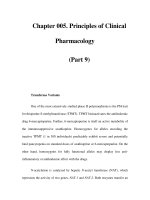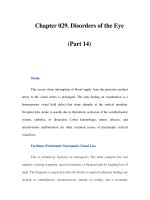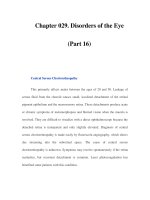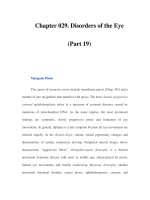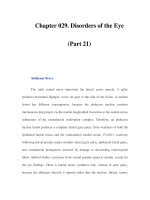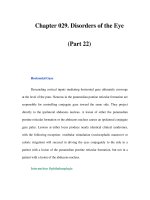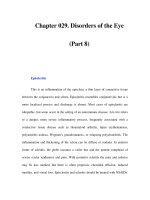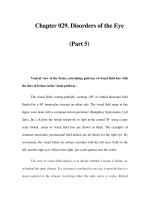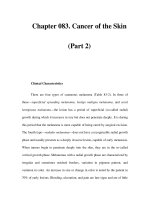Examination of the Newborn - part 9 pps
Bạn đang xem bản rút gọn của tài liệu. Xem và tải ngay bản đầy đủ của tài liệu tại đây (203.42 KB, 23 trang )
practitioners to develop clinical skills in this aspect of their role.
Where deviations from normal do occur, the practitioners must
refer to an appropriate practitioner (UKCC 1998).
The Code of Professional Conduct for the Nurse, Midwife and
Health Visitor (UKCC 1992:1) states that ‘as a registered nurse,
midwife or health visitor, you are personally accountable for your
practice…’ and clearly states how this should be exercised.
Accountability applies to all aspects of practice in which the
professional makes judgements and takes action as a result of
those judgements, for example giving analgesia to a patient in
pain. The professional is answerable for the actions taken and
these should always seek to promote the interests of the
individual patient and the public in general. A professional should
always be able to justify any action taken. The midwife is further
guided by the ‘Midwives rules and code of Practice’ (UKCC 1998),
which defines her role and remit of practice.
Doctors must also recognise their professional accountability
and, in the UK, this has been redefined and presented in the
government’s white paper The New NHS: Modern, Dependable
(DOH 1997). This document introduced the concept of Clinical
Governance through which trusts have a responsibility to ensure
quality of clinical care through the implementation of risk
management systems, evidence-based practice, lifelong learning
and the systematic audit of clinical performance. Such activities
are no longer optional but mandatory.
Legal accountability
Professionals involved in the care of patients have a legal duty to
care for them properly, that is to the standard of a reasonable,
competent member of that profession (the Bolam test). Failure to
do so could result in a patient suing for compensation. In order
for a person suing for compensation (the plaintiff) to be awarded
damages in respect of negligent care it is their responsibility to
demonstrate all of the following:
• The defendant owed a duty of care.
• The defendant was in breach of that duty of care.
• That the damage caused was a direct result of that breech.
It must be noted that ignorance of the law is no defence.
168 EXAMINATION OF THE NEWBORN
Duty of care
The duty of care is clearly established between a health
professional and the client. It consists of those elements that
constitute treatment, information giving, planning and evaluating
care, documentation, supervision and ensuring a safe
environment.
Breach of duty
The level at which care should be delivered has been determined
through application of the Bolam test. This standard requires that
professionals act in a similar manner to a colleague of equivalent
status, no higher, no lower. However, where the midwife has
assumed the duty of a paediatrician, where she undertakes that
duty she should do so with the same skill as the person who
would ordinarily perform it. On assuming that responsibility, the
nurse or midwife would not be able to say, ‘It was my first week’ if
she made a mistake, but should perform it at the same level as
the person who normally undertakes it.
Causation
This is probably the most difficult element of establishing
negligence. Even when a condition had failed to be diagnosed, it
will only constitute negligence if correct diagnosis would have
altered the management of care.
Symon (1998) outlines a case whereby a child had congenital
cataracts, which were not diagnosed during the first examination
of the newborn. However, an ophthalmologist involved in the case,
stated that if the condition had been detected at birth it would
have made little difference to the treatment of the child as the
prognosis for unilateral cataracts is extremely poor. This is not to
suggest that failing to diagnose a condition is without reproach;
however, it is not necessarily evidence of negligence, although
failure to instigate steps to investigate a condition may be in some
circumstances (Symon 1997a). Under current UK law, however,
the plaintiff must show causal association between the breach of
the practitioner’s duty of care and the condition for which
damages are being pursued.
It would be appropriate at this point to refer back to the
question raised at the beginning of the chapter and apply the
three principles of negligent care.
ACCOUNTABILITY AND EFFECTIVE CARE 169
What is the legal position of a practitioner who does not
detect a congenital condition in a baby during the first
examination of the newborn?
THE DEFENDANT OWED A DUTY OF CARE
Clearly, by undertaking a professional role, practitioners owe a
duty of care to their clients.
BREACH OF THE DUTY OF CARE
A practitioner would be in breach of the duty of care if:
1 They did not gain informed consent from the parents.
2 They failed to take steps to identify it.
3 They were not using commonly accepted techniques to
examine the baby.
4 A colleague of equivalent status would have been expected to
detect it.
5 They failed to act on a suspicion of abnormality.
6 They did not document their findings.
7 They did not communicate their findings to the parents.
8 They did not follow up investigations requested.
It is clear from this list, that there are many ways in which a
practitioner could breech her duty of care to a client, even if she
was clinically competent. It is important to ensure that none of the
above apply to your practice. Failure to detect an abnormality that
a colleague of equivalent status would also have missed does not
constitute negligence.
CAUSATION
In order to gain compensation for a condition that was not
detected at the first examination, the parents would be obliged to
prove that detecting it earlier would have made a difference to the
outcome.
Employment
Practitioners have a contractual obligation to abide by the policies
of the trust which employs them and to take due care in the
performance of their duties. The employer has a responsibility to
170 EXAMINATION OF THE NEWBORN
ensure that there are safe systems in place to protect its
employees from harm, such as protective clothing.
Trusts will accept liability for the actions of employees during
the course of their contracted work and will therefore meet the
financial costs of litigation. This is known as vicarious liability. It
is for this reason that it is usually the trust that is named in
negligence cases, even if the trust was not negligent in its duties.
If the employee were negligent, the employee would be in breach
of the contract of employment, and in law the employer would
have the right to be indemnified, although this is unlikely to be
pursued.
When a claim for compensation is made
Despite effective clinical care of the mother and her baby, if a
congenital abnormality is identified there is a small but real
possibility that parents will commence legal action.
Clinical competence alone will not prevent claims being
brought if the outcome is poor.
(Capstick 1993:10.)
Parents often feel that they must do something positive for the
child. It is a terrible fact for parents to face when an abnormality
is discovered in a child. There is often a degree of self-blame, and
in an attempt to assuage that feeling of guilt parents try to do
everything left in their power to alleviate their child’s suffering.
Making a legal claim for compensation is one way that this
phenomenon is manifested.
It is worth bearing in mind that, in England, a change in the
legal aid rules in 1990 means that all claims on behalf of infants are
funded by the state. Even if the practitioner was not negligent in
her duties it is possible that parents, who are distressed because
their baby has an abnormality, will file a claim, and the money is
available to fund it. It is therefore important that there are no
loopholes for the litigant’s lawyer to exploit.
The legal process can be a long and protracted affair, with
delays occurring at any stage along the way. The time taken from
the initial request from the plaintiff’s solicitor to see the case notes
to a case going to court can be many years.
Although the financial cost of litigation, in terms of
compensation, professional time and legal fees, is considerable the
human cost of the anguish experienced by the individuals involved
in the case is immeasurable. It must be acknowledged, therefore,
ACCOUNTABILITY AND EFFECTIVE CARE 171
that action that reduces the risk of negligence claims being filed is
time well spent.
The next section focuses on how the effectiveness of the neonatal
examination can be enhanced in order to ensure that families
receive quality care.
Achieving and maintaining best practice
Practitioners responsible for examination of the newborn should
consider the following issues in relation to their role:
1competence
2 multidisciplinary policy
3 informed consent
4 senior professional and clinical support
5 documentation
6 systematic audit of practice.
Competence
Doctors, nurse and midwives need to address two aspects of their
clinical competence to undertake the examination of the newborn:
gaining competence and maintaining competence.
Gaining competence
Paediatricians who undertake the examination of the newborn are
usually qualified doctors who are working for a paediatric
consultant for approximately 6 months. They may go on to
specialise in paediatrics or family medicine or, alternatively, use
their experience to complement a career in obstetrics. A doctor
undertaking this role will therefore already have considerable skill
auscultating the heart, listening to the chest and palpating the
abdomen in adults. The additional expertise required in order to
care for babies will be gained by working alongside senior
colleagues, caring for sick neonates and through personal study.
For midwives and nurses to gain the extra skills in order to be
competent to perform the full examination of the newborn, it is
necessary for them to undertake a post-registration programme of
study that exposes the practitioner to this new sphere of practice.
This education combines theory with practice and is currently
available in the United Kingdom as a recognised course, originally
pioneered by Stephanie Michaelides (1995). A senior paediatrician
assesses clinical competence, and on successful completion of the
172 EXAMINATION OF THE NEWBORN
course the midwife is able to practice the new skill within the
remit of the local policy and trust guidelines. As more nurses and
midwives become skilled and experienced in this clinical
examination, they will be able to assess the competence of their
peers.
Maintaining competence
The Code of Professional Conduct (UKCC 1992, par 3), which both
nurses and midwives must abide by, states that as a registered
professional, the practitioner must ‘maintain and improve
professional knowledge and competence’. According to the
midwives code of practice (UKCC 1998):
You are responsible for maintaining and developing the
competence you have acquired during your initial and
subsequent midwifery education.
(UKCC 1998:28, para 3)
It is central to the practice of all health professionals that they
acknowledge the limits of their own individual competence. It is
important that practitioners do not run the risk of continuing to
care when they are out of their clinical depth by thinking ‘I ought
to know this’ and not seeking advice from senior colleagues
because they are too embarrassed to admit that they do not know.
It is difficult for senior professionals, who are often seen as the
font of all knowledge, to admit to not knowing something, but it
would be much more difficult do the same in court. The remit for
nurses and midwives is clearly stated in their code of conduct and
they must:
…Acknowledge any limitations in your knowledge and
competence and decline any duties or responsibilities unless
able to perform them in a safe and competent manner.
(UKCC 1992: para 4)
Nurses and midwives are in the fortunate position of usually
staying within their speciality for a substantial length of time,
thus being able to continue to build on their knowledge and
expertise, which junior doctors who are moving between
departments every 6 months do not have the luxury of (Denner
1995).
ACCOUNTABILITY AND EFFECTIVE CARE 173
Multidisciplinary policy
The first examination of the newborn is not currently part of the
role of all midwives or neonatal nurses. It is essential, therefore,
that the midwife or nurse is supported in this expansion of her
role by a locally agreed policy that clearly sets out the limits and
provides clear guidelines for referral to a paediatrician when
support or guidance are required.
The process of sitting down together with fellow colleagues to
construct a multidisciplinary policy is an extremely valuable one.
Each professional group will gain insight into the constraints and
obligations of their respective roles, and this will enhance their
future working relationship.
An example of such a policy might include the following;
Neonatal examination by a nurse or midwife
(practitioner)
Introduction
Examination of the newborn is performed on all babies
within the first 24 hours of life. It is currently performed by
paediatric senior house officers, general practitioners and,
increasingly, midwives and neonatal nurses. Its purpose is to
exclude major congenital abnormality and reassure the
parents that their baby is healthy. As the length of postnatal
stay in hospital is declining, this first examination is often
combined with the traditional discharge examination by the
doctor and confirms the baby’s fitness to go home. It is,
therefore, an important screening procedure and health
promotion opportunity.
Since the publication of the document Changing Childbirth
(DOH 1993a) midwives are exploring ways that enable them
to provide continuity of care to women and their families.
Midwives, without medical input, transfer fit and healthy
women to community care. Many midwives feel that after
receiving the appropriate education and clinical experience
they are best placed to transfer the care of babies into the
community.
Aim
To provide parents with the opportunity to have their baby
examined by a neonatal nurse or midwife who is competent
in this role.
Objectives
174 EXAMINATION OF THE NEWBORN
The practitioner will
• have a minimum of 2 years of post-registration
experience;
• have successfully completed a course of preparation;
and
• have access to 24-hour senior paediatric support in the
event of an abnormality being either detected or
suspected.
Protocol
The practitioner will
• undertake the examination within the first 24 hours of
the baby’s birth;
• obtain informed consent from a parent;
• undertake examinations on babies that are term,
singletons with no known or expected anomalies;
• undertake a full medical examination of the baby in the
presence of a parent informed by knowledge of the
obstetric, medical and family history;
• make detailed records of the examination in the
appropriate case notes;
• record any deviation from normal and inform the
paediatrician, informing parents of all findings;
• decline to undertake an examination of a baby when
workload pressures or other such circumstances would
prevent the examination receiving the attention it
requires. In such circumstances the paediatrician or
general practitioner would be requested to undertake
the examination.
Reviewed by: (senior nurse/midwife/paediatrician)
Review date:
The practitioner could also use the opportunity to draw together
an information leaflet for parents outlining the focus of the first
examination of their baby, thus making a contribution to the
problem of gaining ‘informed consent’.
Informed consent
Although the examination of the newborn is a clinical examination
that is routinely performed on all day-old babies, consent is still
required from the parents before it can be undertaken. In the
ACCOUNTABILITY AND EFFECTIVE CARE 175
context of the examination of the newborn the practitioner needs
to be aware of both the legal and the professional aspects of
gaining consent.
Legal aspects of gaining consent
We have already seen that professionals have a duty of care to
provide information to patients, without which they are unable to
make an informed choice. Ideally this information should be made
available to women before they have to make a decision, so that
there is opportunity for them to ask questions and raise concerns.
Unfortunately, it is often the case, particularly with non-invasive
tests such as ultrasound scanning, that little information is given
prior to the event, if at all. Parents are likely to be devastated if
their previously ‘normal’ baby is suddenly found to have a life-
threatening abnormality, the diagnosis of which could have been
initiated by the neonatal examination. Of course, it would be
inappropriate to attempt to prepare every parent for the possibility
that a major defect will be detected, but they should know that it
is a screening procedure.
It must also be acknowledged that failure to gain consent from
the parents to undertake the examination of their baby could also
be seen as assault in legal terms. It is also essential that the
designation of the practitioner is made clear to parents. If a parent
expects a procedure to be undertaken by a doctor, and has no
reason to believe that it is not being undertaken by a doctor, then
consent may be invalid if the procedure were then undertaken by
a nurse or midwife (Martin 1997).
Professional aspects of gaining consent
Maternity services are increasingly endeavouring to offer choices
to women regarding the type of care they receive following the
recommendations of the document ‘Changing Childbirth’ (DOH
1993a). In order to make choices, however, women need access to
relevant, unbiased information in a language that is meaningful to
them. Parents will need to know who you are, the options
available, what you are going to do and advantages and
disadvantages of the procedure.
Who you are
Your status and evidence of this should be clearly given to
parents. Many professionals do not wear a uniform and this can
176 EXAMINATION OF THE NEWBORN
be confusing for parents. The fear of abduction of babies from
maternity units is a real one, and for this reason you should not
attempt to remove the baby from the mother’s side. Where
conditions are not conducive to a personal and thorough
examination of the baby, parents should accompany you to a
more private location. If you are a nurse or a midwife, you should
inform them that you have undertaken further education and
supervised practice in order to undertake this role (Dowling et al.
1996).
Options available
Depending on the model of care that is operating within the
maternity unit, parents should be able to choose to see either a
doctor, a nurse or a midwife, without being put under pressure to
make a choice. As a nurse or a midwife it would be very easy to
say ‘you can see a doctor but you will have to wait because they
are very busy on the special care baby unit, but I could see you
now’. On the other hand, parents do have a right to know the
facts, so it might be more appropriate to say, ‘you are welcome to
see a doctor if you would prefer, and I will find out for you when
he or she will be available’. The reality is that most parents will
opt to do what everyone else is doing, but their choice of
practitioner should be a real one.
What you are going to do
The purpose and content of the examination should be clearly
outlined to the parents. They should be reassured that any
significant findings will be discussed with them and that they are
free to ask questions during the examination. Failing to
communicate effectively is one of the most frequent complaints in
health care (DOH 1994).
Advantages and disadvantages of the procedure
This is a very important aspect of gaining informed consent for a
procedure. Examination of the newborn is a screening test and as
such should be presented in the light of its ability to detect
abnormality. Parents need to be aware that although the
examination of their baby can exclude conditions such as
congenital cataracts it may not detect some forms of heart disease
(MacKeith 1995). The converse is also true: where a lax hip joint is
ACCOUNTABILITY AND EFFECTIVE CARE 177
detected during this initial examination, it may not be evident
subsequently.
Senior professional and clinical support
During the course of professional practice, in every field of health
care, there will be the need to consult an expert or seek a second
opinion regarding a particular clinical situation. Multidisciplinary
team work is vital in the provision of effective, quality care for the
family unit. Examining the neonate is such a situation where
sometimes confirmation of an observation, such as a suspected
heart murmur, is required in order to ensure that the appropriate
care is given. It must therefore be ensured that where a
practitioner is responsible for examining a neonate that senior
paediatric support is available for advice and guidance when
needed. This should be clearly documented in the protocol that
the practitioner works within so that there is no confusion about
who that clinician might be at any given time.
Professional support is also required so that the practitioner can
discuss any issues pertaining to practice, such as continuing
professional development and workload pressures. In midwifery,
the practitioner can approach the supervisor of midwives for
support and guidance. The practising midwife has 24-hour access
to a supervisor of midwives, who can offer advice and information
enabling the midwife to continue to provide quality care. The remit
of the supervisor of midwives is to safeguard the mother and her
baby by ensuring that midwives are able to maintain and develop
their professional knowledge while acknowledging the limits of
their competence. Increasingly in nursing, clinical supervision is a
mechanism that enables the practitioner to reflect on professional
and practice issues (Cowe and Wilkes 1998). Supervisors are
optimally placed to understand the unique culture of the
organisation in which the practitioner is working and therefore be
empathetic to her needs. Practitioners should meet regularly with
their supervisors not only for professional support, but also to
discuss and evaluate their roles within ever evolving health
services.
Documentation
Records are a vital way in which health care professionals
communicate with each other. The nature of health care work is
such that we see many patients each day in similar
circumstances, but requiring individualised care. Records help
178 EXAMINATION OF THE NEWBORN
ensure that observations are communicated to colleagues,
including any subsequent action taken, who was involved and
when. Many maternity records are patient-held and therefore the
parents may have access to this information in the comfort of
their own home. Just because the parents do not have a medical
or legal background does not mean that their friends and relatives
do not. There are some basic requirements that help make records
effective:
• Do not use abbreviations unless a standard list of locally
approved abbreviations accompanies each set of records.
Abbreviations are open to misinterpretation and can lead to
mistakes being made.
• Always date, time and sign each entry, stating your
designation at least once on the record.
• Always write in black as it photocopies much more clearly
should a copy be required.
• If you have requested referral, further tests or investigations
ensure that they are documented and evaluated. All actions
taken and advice given should be clearly written.
• It is also relevant to document circumstances that may have
contributed to an inability to perform the examination
adequately. Such an entry must be accompanied by a plan to
deal with the situation. Table 7.1 illustrates how this might
apply in practice.
• If unavoidable circumstances had prevented the practitioner
from returning to the baby, the situation should be explained
to the mother and alternative arrangements made and
documented in the case notes.
• Do not make amendments to records with correction fluid,
but if necessary score a single line throughout the text so
that what is written underneath can be clearly read, write
‘written in error’ and sign the entry.
• Where possible use language that is clear and accessible to
the client so that it can be read with a minimum of
translation. This will avoid confusion and fear caused by the
use of jargon and technical language. Records should be
written bearing in mind that the patients have access to all
written records about themselves which were made after
November 1991 (Access to Health Records Act 1990). They
should therefore not contain any material which might be
subjective, offensive or irrelevant. In ideal circumstances
records should be made in front of patients so that they have
a full knowledge of what observations have been documented.
ACCOUNTABILITY AND EFFECTIVE CARE 179
It cannot be emphasised too strongly how important clear, concise
records are; further detail is provided in the document ‘Guidelines
for Records and Record Keeping’ (UKCC 1998a). Excellence in
record keeping is central to proactive risk management. The
existence of accurate, contemporaneous records may actually
prevent a case ever coming to court. If a plaintiff’s solicitor writes
to the hospital trust outlining a possible claim and asking for the
case notes to be disclosed, this is when cases are often either
thrown out or pursued. There is a professional duty to keep such
records and failure to do so may lead to the assumption that the
care also failed to come up to scratch. A useful aspect to bear in
mind when considering record keeping is the maxim that ‘if it is
not documented it did not happen’.
Detailed patient records are an investment for the future
because the child who is damaged in the perinatal period has up
to 21 years in which to file a claim; there is no time limit for a
child who is deemed incapable of managing their own affairs
(Capstick 1993). Accurate records are therefore invaluable as many
staff have difficulties recollecting a particular case (Symon 1997b).
We cannot see into the future and predict which parents will file
for negligence on behalf of their child. It would be almost
impossible to remember the precise details of what actions were
taken or what referrals were made many years after the event.
Although it may seem tedious at the time to make detailed notes of
TABLE 7.1 An example of a written entry in the notes
180 EXAMINATION OF THE NEWBORN
such interactions, if a case were brought to court these records
would form an essential part of the defence.
It has been shown how clear, accurate and detailed records can
assist the delivery of quality care and also act in a practitioners
defence should a negligence case be initiated.
Systematic audit of practice
Audit is ‘the systematic and critical analysis of the quality of
clinical care’ (DOH 1993b), and through the implementation of
clinical governance in the National Health Service in the UK it is
an integral part of health care provision (DOH 1997). Audit
involves identifying what is best practice, setting standards and
then comparing practice against those standards. It is a dynamic
process through which changes can be recommended and then
subsequent care re-audited, and thus the cycle continues.
There are many aspects of the examination of the newborn
process that can be audited in order to ensure that quality of care
is continually improved.
Donabedian (1966) suggested three aspects of care that,
through their examination, can assist the practitioner to enhance
quality issues. These are: structure, process and outcome (see
Table 7.2).
Audit involves change, and it is therefore important that the
people who the change would effect are involved at the beginning
of any audit project. Planning should include all members of the
multidisciplinary team and managers who might be responsible
for implementing any of the recommendations.
Conclusion
This chapter has given readers an insight into how their
professional and legal accountability affect their role when
TABLE 7.2 Donabedian’s dimensions of quality
ACCOUNTABILITY AND EFFECTIVE CARE 181
undertaking the first examination of the newborn. There are many
ways in which the practitioner can enhance the effectiveness of
the examination, thus minimising the risk of mistakes being made
and negligence suits being filed.
It is a privilege to be with women and their families at this
special time in their lives. Every possible care should be taken to
ensure that as health care professionals, we make a positive
contribution to the experience of the birth of their baby.
182 EXAMINATION OF THE NEWBORN
Appendix 1
Useful addresses
Action on Smoking and Health (ASH)
5/11 Mortimer Street, London W1N 7RH
Tel: 020 7637 9843 Fax: 020 7436 4750
Alcoholics Anonymous
PO Box 1, Stonebow House, Stonebow, York YO1 2NJ
Tel: 01904 644026
Association for Children with Hand or Arm Deficiency
(REACH)
12, Wilson Way, Earls Barton, Northamptonshire, NN6 0NZ
Tel: 01604 811041 Fax: 01604 811041
Association for Improvements in Maternity Services (AIMS)
40 Kingswood Avenue, London, NW6 6IS
Tel: 020 8960 5585 Fax: 01753 654142
Association for Spina Bifida and Hydrocephalus (ASBAH)
42 Park Road, Peterborough, Cambs PE1 2UQ
Tel: 01733 555988 Fax: 01733 555985
E-mail:
Baby Life Support Systems (BLISS)
17–21 Emerald Street, London WC1N 3QL
Tel: 020 7831 9393 Fax: 020 7404 0676
Body Positive
51B Philbeach Gardens, London SW5 9EB
Tel: 020 7835 1045
Fax: 020 7373 5237
British Institute for Brain Injured Children
Knowle Hall, Knowle, Bridgwater, Somerset, TA7 8PJ
Tel 01278 684060 Fax: 01278 685573
British Heart Foundation
102 Gloucester Place, London, W1H 4DH
Tel: 020 79350185
British Diabetic Association
10 Queen Anne Street, London W1M 0BD
Tel: 020 76366112 Fax: 020 76373644
E-mail:
British Pregnancy Advisory Service
Austy Manor, Wooton Wawen, Solihull, West Midlands B95 6BX
Tel: 01564 793225 Fax: 01564 794935
Brook Advisory Centres
165 Grays Inn Road, London WC1X 8UD
Tel: 020 7833 8488 Fax: 020 7833 8182
Caesarean Support Network
55 Cooil Drive, Douglas, Isle of Man IM2 2HF
Tel: 01624 661269
Cleft Lip and Palate Association (CLAPA)
134 Buckingham Palace Road, London SW1 9SA
Tel: 020 7824 8110 Fax: 020 7824 8109
Cry-sis
B.M. Cry-sis, London WC1N 3XX
Tel: 01634 710913 Fax: 01634 710913
Cystic Fibrosis Research Trust
Alexandra House, 5 Blyth Road, Bromley, Kent BR1 3RS
Tel: 020 8464 7211 Fax: 020 8313 0472
Cystic Hygroma and Haemangioma Support Group (CHHSG)
Villa Fontane, Church Road, Worth, Crawly, West Sussex RH10
4RS
Tel: 01293 885901 Fax: 01293 882460
Disfigurement Guidance Centre
PO Box 7, Cupar, Fife KY15 4PF
Tel: 01337 870281 Fax: 01337 870 310
Down’s Syndrome Association
155 Mitcham Road, Tooting, London SW17 9PG
Tel: 020 86824001 Fax: 020 86824012
Drugline
9a Brockley Cross, Brockley, London SE4 2AB
Tel: 020 86924975
Dystrophic Epidermolysis Bullosa Research Association
(DEBRA)
Debra House, 13 Wellington Business Park, Dukes Ride,
Crowthorne RG45 6LS
Tel: 01344 771961 Fax: 01344 762661
Foresight: Association for the Promotion of Preconceptual
Care
28 The Paddock, Godalming, Surrey GU7 1XD
Tel: 01483 427839 Fax: 01483 427668
Foundation for the Study of Infant Deaths
14 Halkin Street, London SW1X 7DP
Tel: 020 72350965 Fax: 020 78231986
184 EXAMINATION OF THE NEWBORN
Gingerbread (Association for one parent families)
16/17 Clerkenwell Close London EC1R 0AA
Tel 020 73368183 Fax: 020 73368185
E-mail:
Herpes Viruses Association (HVA SPHERE)
41 North Road, London N7 9DP
Tel: 020 76079661
Hospice Information
St Christopher’s Hospice, 51–59 Lawrie Park Road, Sydenham,
London SE26 6DZ
Tel: 020 87789252
La Leche League of Great Britain
BM 3424, London WC1V 6XX
Tel: 020 72421278
MAMA Meet a Mum Association
Cornerstone House, 14 Willis Road, Croydon, Surrey CR0 2XX
Tel 020 86650357 Fax: 020 86651972
Maternity Alliance
45, Beech Street, London EC2P 2LX
Tel: 020 75888583 Fax: 020 75888584
Naevus (Birthmark) Support Group
58 Necton Road, Wheathampstead, Herts AL4 8AU
Tel: 01582 832853
(STEPS) National Association for Families of Children with
Congenital Abnormalities of the Lower Limbs
15, Statham Close, Lymm, Cheshire WA13 9NN
Tel: 01925 757525 Fax: 01925 757525
E-mail:
National Childbirth Trust
Alexandra House, Oldham Terrace, Acton, London W3 6NH
Tel 020 89922616 Fax: 020 89925929
National Deaf-Blind and Rubella Association (SENSE)
11–13 Clifton Terrace, Finsbury Park, London N4 3SR
Tel: 020 72727774 Fax 020 72726012
National Eczema Society (NES)
163 Eversholt Street, London NW1 1BU
Tel: 020 7388 4800 Fax: 020 73885882
National Meningitis Trust
Fern House, Bath Road, Stroud, Glos GL5 3TJ
Tel: 01453 751738 Fax: 01453 753588
National Stepfamily Association
3rd Floor, Chapel House, 18 Hatton Place, London EC1N 8RU
Tel: 0990 168388 Fax: 020 72092461
Parentline
USEFUL ADDRESSES 185
Endway House, The Endway, Hadleigh, Essex SS7 2AN
Tel: 01702 554782 Fax: 01702 554911
Pre-eclamptic Toxaemia Society (PETS)
12 Monksford Drive, Hullbridge, Hockley, Essex SS5 6DQ
Tel: 01702 230493
Royal National Institute for Deaf People (RNID)
19–23 Featherstone Street, London EC1Y 8SL
Tel: 020 72968000 Fax: 020 72968199
Royal National Institute for the Blind (RNIB)
224 Great Portland Street, London W1N 6AA
Tel: 020 73881266 Fax 020 73882034
E-mail:
Samaritans
17 Uxbridge Road, Slough SL1 1SN
Tel: 01753 32713 Fax: 01753 24322
Sickle Cell Society
54 Station Road, Harlesden, London NW10 4UA
Tel: 020 89617795 Fax: 020 89618346
SCOPE
12 Park Crescent, London W1N 4EQ
Tel: 020 76365020 Fax: 020 74362601
Stillbirth and Neonatal Death Society (SANDS)
28 Portland Place, London W1N 4DE
Tel: 020 74365881 Fax: 020 74363715
Terrence Higgins Trust
52–54 Grays Inn Road, London WC1X 8JU
Tel: 020 7831 0330 Fax: 020 78164552
E-mail:
Twins and Multiple Births Association
PO Box 30, Little Sutton, South Wirral L66 1TH
Tel: 0151 3480020 Fax: 0151 2005309
186 EXAMINATION OF THE NEWBORN
Appendix 2
Safe sleeping environment for
babies: advice for parents
•Smoke-free
• Room temperature approximately 18°C
• Lie baby on its back
• Do not wedge baby on its side
• Do not overwrap baby
• Use several thin layers of blankets
• Do not use pillow or duvet
• Lie baby with its ‘feet to foot’ of the cot
• Ensure no loose ties on clothes/toys
• No flexes/mobiles within reach of crib
• Keep animals out of room
• Install smoke detector
Note
For further information contact the Foundation for the Study of
Infant Death (FSID),
14 Halkin Street, London SW1X 7DP
24-hour helpline: 020 7235 1721
188
References
Access to Health Records Act (1990) HMSO: London.
ACOG Technical Bulletin (1993) Perinatal viral and parasitic infections.
International Journal of Gynaecology and Obstetrics 42(177): 300–7.
Adhikari M, Gouws E, Velaphi SC, Gwamanda P. (1998) Meconium
aspiration syndrome: importance of the monitoring of labour. Journal
of Perinatology 18(1): 55–60.
Adra AM, Mejides AA, Dennaoui MS, Beydoun SN (1995) Fetal pyelectasis:
is it always ‘physiologic’? American Journal of Obstetrics and
Gynaecology 173(4): 1263–6.
Akhter MS (1976) An unusual complication of intrapartum fetal
monitoring. American Journal of Obstetrics and Gynaecology 15: 657–
8.
Alcock KM (1992) Teenage pregnancy and sex education. British Journal of
Family Planning 18(3): 88–92.
Alderice F, Renfrew M, Marchant S, Ashurst H, Hughes P, Berridge G,
Garcia JI (1995) Labour and birth in England and Wales: survey
report. British Journal of Midwifery 3(7): 375–82.
Alexander JM, Cox SM (1996) Clinical course of premature rupture of the
membranes. Seminars in Perinatology 20(5): 369–74.
Allott H (1996) Picking up the pieces: the post-delivery stress clinic.
British Journal of Midwifery 4(10): 534–6.
Alroomi LG (1988) Maternal narcotic abuse and the newborn. Archives of
Diseases in Childhood 63(1): 81–3.
Armant DR, Suanders DE (1996) Exposure of embryonic cells to alcohol:
contrasting effects during preimplantation development. Seminars in
Perinatology 20(2): 127– 39.
Bardy AH, Seppala T, Lillsunde P, Kataja JM, Koskela P, Pikkarainen J,
Hiilesmaa VK (1993) Objectively measured tobacco exposure during
pregnancy: neonatal effects and relation to maternal smoking. British
Journal of Obstetrics and Gynaecology 100: 721–6.
Beal SM, Byard RW (1995) Accidental death or sudden infant death
syndrome? Journal of Paediatric Child Health 31(4): 269–71.
Beckwith J, Read M (1996) Prelabour rupture of membranes at term:
home management. British Journal of Midwifery 4(2): 74–5.
Bennett VK, Brown LK (eds) (1999) Myles Textbook for Midwives, 13th
edn. Churchill Livingstone: London.
Boivin JF (1997) Risk of spontaneous abortion in women occupationally
exposed to anaesthetic gases: a meta-analysis. Occupational
Environmental Medicine 54(8): 541– 8.
Bowlby J (1953) Child Care and the Growth of Love. Penguin: London.
Brown L (1998) The tide has turned audit of water birth. British Journal
of Midwifery 6(4): 236–43.
Butler N, Ineichen B, Taylor B, Wandsworth J (1981) Teenage Mothering.
2. Report to DHSS, University of Bristol: Bristol.
Butler NR, et al. (1972) Cigarette smoking in pregnancy: its influence on
birthweight and perinatal mortality. British Medical Journal 15: 127–
30.
Campbell MK (1998) Factors affecting outcome in post-term birth.
Current Opinion in Obstetrics and Gynaecology 9(6): 356–60.
Campion P, Owen L, McNeill A, McGuire C (1994) Evaluation of a mass
media campaign on smoking and pregnancy. Addiction 89: 1245–54.
Capstick B (ed.) (1993) Litigation. A risk Management Guide for Midwives.
The Royal College of Midwives: Kent.
Carbonne B, Langer B, Goffinet F, Audibert F, Tardif D, Le Goueff F,
Laville M, Maillard F (1997) Multicenter study on the clinical value of
fetal pulse oximetry. II. Compared predictive values of pulse oximetry
and fetal blood analysis. The French Study Group on Fetal Pulse
Oximetry. American Journal of Obstetrics and Gynaecology. 177(3):
593–8.
Chalmers JA, Chalmers I (1989) The obstetric vacuum extractor is the
instrument of first choice for operative vaginal delivery. British Journal
of Obstetrics and Gynaecology 98: 505–9.
Chan A, McCaul KA, Cundy PJ, Haan EA, Byron-Scott R (1997) Perinatal
risk factors for developmental dysplasia of the hip. Archives of
Disease in Childhood 76(2): F94– F100.
Chaplin J, McDiarmid P (1992) Teenage parenthood—myth and reality.
Community Health Action 25(Autumn): 3.
Chattingius S, Haglund B (1997) Decreasing smoking prevalence during
pregnancy in Sweden: the effect on small for gestational age births.
American Journal of Public Health 87(3): 410–3.
Chen ZL (1992) A case-control study on the relationship between neonatal
hyperbilirubaemia and usage of oxytocin during labour. Chung Hua
Hsing Ping Hsueh Tsa Chih 13(5): 294–6.
Chew S, Anandakumar C, Wong YC (1995) Fetal choroid plexus cysts and
their association with aneuploidy. Journal of Obstetrics and
Gynaecology 15(6): 359–62.
Corson SL (1998) Achieving and maintaining pregnancy after age 40.
International Journal of Fertility and Womens Medicine 43(5): 249–56.
Cowe F, Wilkes C (1998) Clinical supervision for specialist nurses.
Professional Nurse 13(5): 284–7.
Crang-Svalenius E, Dykes AK, Jorgensen C (1996) Organised routine
ultrasound in the second trimester . One hundred womens
experiences. Journal of Maternal-Fetal Investigation 6(4): 219–22.
Crompton J (1996) Post-traumatic stress disorder and childbirth. British
Journal of Midwifery 4(6): 290–5.
Denner S (1995) Extending professional practice: benefits and pitfalls.
Nursing Times 91(14): 27–9.
Department of Health (1993a) Changing Childbirth. HMSO: London
190 REFERENCES
